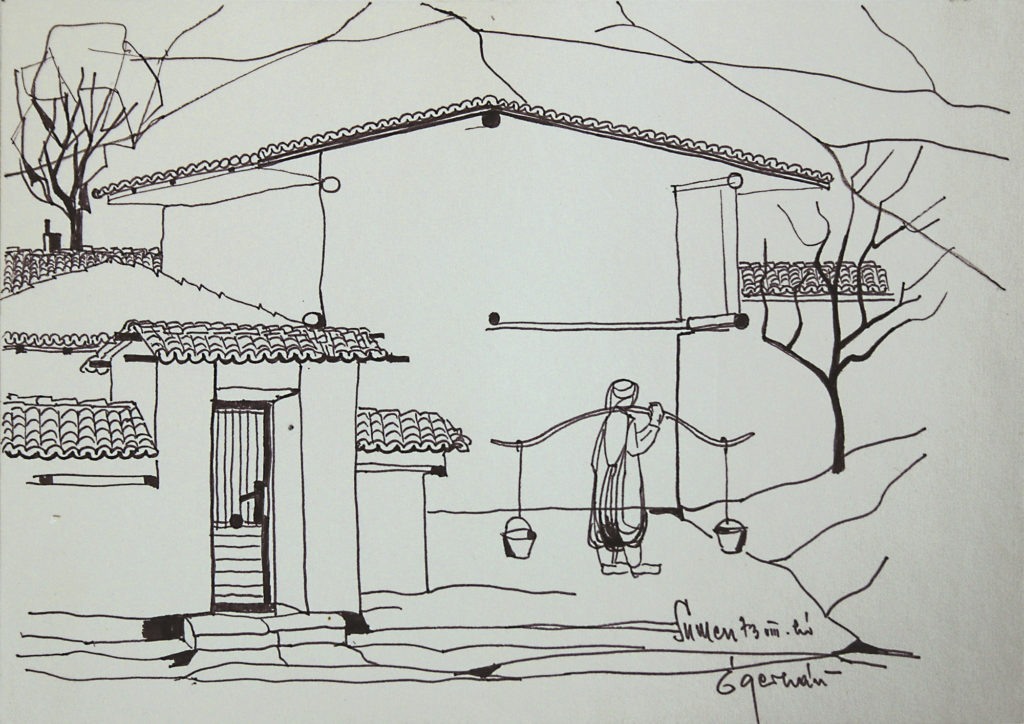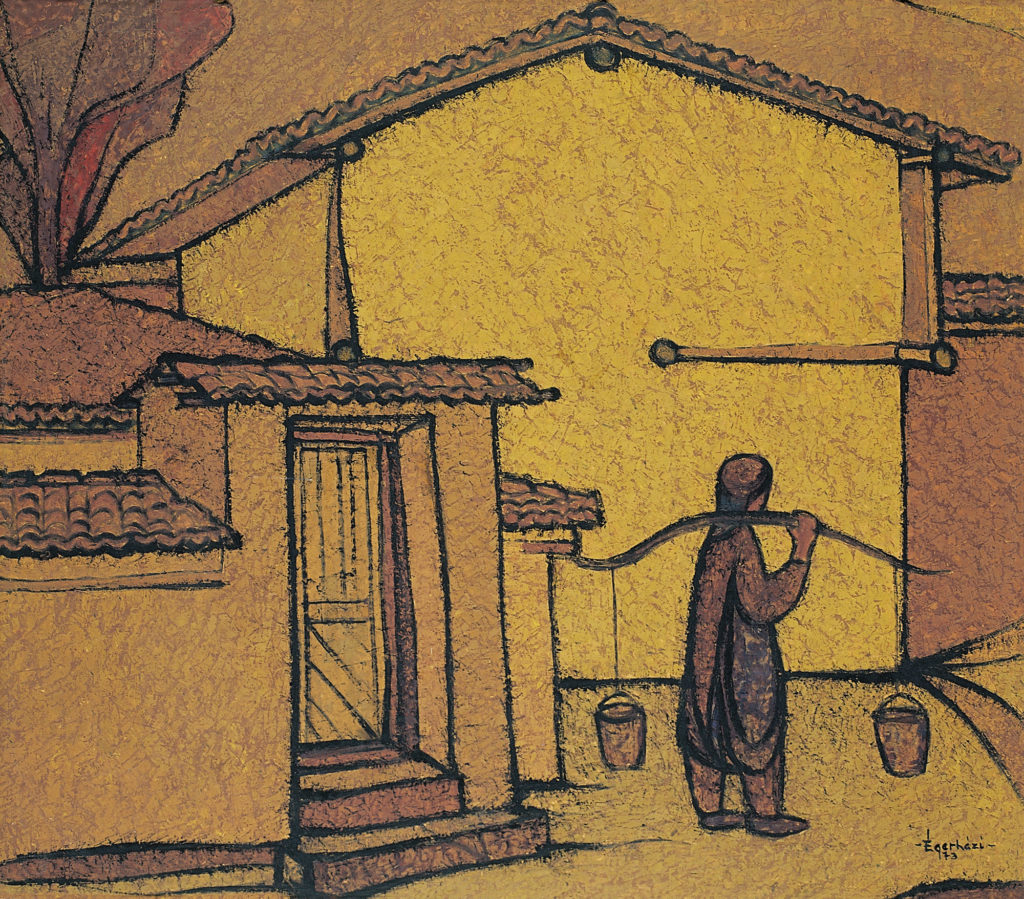We lived in Hajdúhadház, I was in primary school, in my first class, when from my teacher József Szabó I received that particular chalk, with which I drew on the surrounding village houses, white-wall houses, grey fences that we called the plank fences. Normally, of what I saw around myself, from the world around me. Because of this there was always trouble, as either the wall of the house had to be whitewashed the fence had to be tided up, or I was disciplined, smacked for what I did. From then on I had some intense compulsion, the compulsion, which is with sportsmen, I think, the must run, jump, go out to the court, take deep breaths and do something, just because compulsion. Maybe not because he would be the best runner in the county, but some compulsion which drives him. It is the same with art that some compulsion drives the man that he would draw. Paint at times when he could have gone to the beach, gone for a walk, maybe had a good time with girls, and he just sat down and did something he liked doing, and did it willingly. And this meant joy, satisfaction and spiritual balance.
Many people appeared at my exhibitions and were looking at my paintings and I was glad that they were appreciative, so that, what I did they understood and could buy the ideas. If they come across a picture, which they could understand with difficulty, we could still understand each other because what I do is an abstract, a disregard, in such a measure, that even a simple person can take it in. Therefore the objects, the visual experience to which the picture is bound, for on the picture there is a lot of the atmosphere, so if the viewer looks at the picture, he can find a lot of features, moods that he could feel from the scene. The abstract is not happening on one level it almost separates. One line is the abstract of objects, countryside, the other is people, the human face and the abstracts of human movement or structural standing figures. The most fortunate case is if both of them happen on one level, this way it is easier to understand the picture, too. With most painters this is a serious problem, that the abstract is not happening on one level and they are fighting, battling with the material, the figure, the mean of expression so that they can get to one level. This resulted in a serious task and problem for me, also, and normally those pictures were sold quicker and were explained easier, where in the visual experience the human abstract was not on such a high level as the objects or county abstract. Therefore not much had to be explained to the people standing in front of the pictures about what and why I do things in the case of pictures with figures.
Alternatively in the case of my landscapes, where I laid everything out onto one level, and I did the abstract in two dimensions at a higher level, I had to tell and explain that the same mood and the same experience can be demonstrated in a different way too. And so in the case of these pictures I did not need to explain but rather talk about what and why I did things on that particular picture.
I like painting the peasant world; villages, village-people the most. Although the Transylvanian pictures have recently been dominant, now even these have come off the schedule because the Transylvanian experiences; the Transylvanian beautiful countryside, the Transylvanian people’s battle with the adverse nature,-this big impression, has faded somewhat because I am full of Bulgarian experiences, memories, drawings, drafts of the study tour, and so I am treating them at the moment. I am, therefore, adjusting to these triple circles. These topics then are shown in different means of expressions – lino cutting, monotype copperplate and board pictures. According to which topic is for which, and how they can be the most expressive. The Bulgarian study tour was only one of many foreign tours.
In the last 15 years, almost every year I have visited one of the surrounding socialist states, there was such, as for instance Romania, where I went several times in a year and I got to know may creators and I saw lots of pictures. I got familiar with their problems. But even all of these together do not give me so much as the international colony of artists to which painters come to work in every year for a month, in July. It is a little bit like connecting into the circuit of the European art of panting. Work in the colony of artists has been so substantial and considerable, not only in my life but the participating painters also, that after the braking up of the colony, for months they are still under its impression and they continue their work on the base of the received impulses. Examples can be lined up on the outstanding performances of either Soviet, Romanian or Jugoslavian painters, because of the intellectual effect of the colony of artists in Böszörmény. It is the same case with me.
On the colony of artists not only serious arguments, problems, work of art appraisals, expert meetings take place, but also excursions, humorous stories, enjoyable moments, those, on which we laugh a lot. For instance on one occasion, one of the agricultural co-operatives assured us of a car to be able to go to the countryside and draw there. Then one of the drivers asked us “When should that car come and pick you up, then?” We told him to send the car to fetch us around noon because we would have drawn enough by then from which, at home, we can draw a picture. He gave such a surprised expression, and was almost terrified. Then he said, “Wow, by then you will have drawn all those 4 thousand acres? “Well, that is a bit early,” he said, “I think we should send that car in the evening, you will have got a bit further by then.”
Imre Égerházi
László János Nagy
Brief description
Debrecener teacher László János Nagy was a good friend of Imre Égerházi, and a well-known amateur filmmaker, whom with Égerházi took part in several joint study trips, and also made films and sound recordings together.
In 1973, they traveled together to Transylvania for the Csángó Festival, and made 8mm films, sound recordings and plenty of slides about the event. The title of the first Csángó Festival held in Gyimes was named the ‘String of Friendship.’ The Debrecener artists immortalized the unusual event of the Hungarian culture present in Transylvania, in very harsh and unfriendly conditions due to the Romanian authorities.
In 1974, László János Nagy shot a great portrait film about Imre Égerházi, introducing both the painter and the man. The premiere of the film took place at the Apolló Cinema in Debrecen, together with several other short films by László János Nagy.
Their relationship remained close, and László János Nagy was the host of several exhibitions by Imre Égerházi.
In 1986, László János Nagy made a film about the Hortobágy Creative Camp led by Imre Égerházi, and in 1987 about the colony’s study tour in France.




